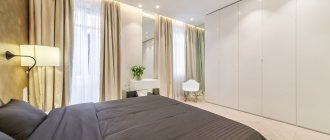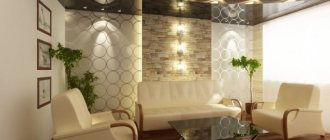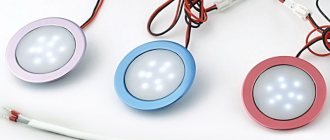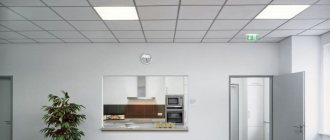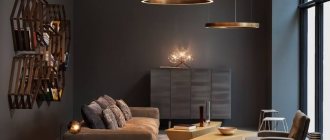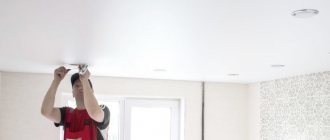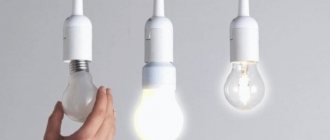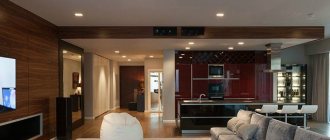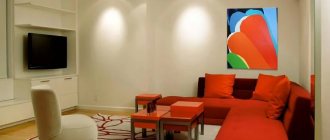11/17/2016 master
Repairing the ceiling is quite a responsible undertaking, which, among other things, involves a wide variety of calculations. Here it is necessary not only to calculate the repair budget, but also to correctly calculate how many lamps, especially if spotlights will be used, will need to be installed. To find out, the first thing you need to do is decide what distance between the lamps should be.
Ceiling lamps
Moreover, such calculations are important not only for creating a general lighting system in the house, but also in production (for example, for security, emergency, etc. types of lighting). Our article will tell you about everything related to this type of calculation.
Why is the calculation carried out?
According to regulatory documentation (SNiP, SanPin), the lighting system in any room must comply with certain requirements, which primarily relate to the level of illumination. Each home or industrial premises must have its own lighting levels, which are implemented by different types of lamps (emergency, general, local, work and other purposes). All indicators of the degree of illumination for various rooms are given in SNiP. An example of the level of illumination that should be implemented in various rooms is given in the table.
Note! The required illumination level is shown in the table at a minimum level. Therefore, a slight upward adjustment is allowed.
Table. Indoor lighting level
Such standards were developed to ensure that people in the premises do not experience discomfort. To determine the optimal level of illumination for each specific room, the calculation must take into account a number of indicators:
- type and purpose of the premises;
- type of lighting (general, emergency, work or other purposes);
- type of lamps, as well as their location (on the ceiling, wall, work surface);
- type of light source. For lighting a home and industrial premises (security, emergency, work purposes), the calculation can use the operating parameters (power, etc.) of incandescent, LED, fluorescent and other types of lamps.
Types of light bulbs
However, it is not enough to know the above indicators. The calculation must also determine how many light bulbs and luminaires need to be used to create the level of illumination required by SNiP standards. And to find out, you need to find out what the distance will be between the lamps used. If you do not make such a calculation, then you are unlikely to be able to create eye-pleasing lighting in the room. Moreover, this calculation is most complex for industrial facilities when organizing emergency, work, general and other lighting options.
Arrangement of lamps on a suspended ceiling - overview of options and recommendations
- Incandescent lamps. They are inexpensive and easy to replace. But you need to take into account that low-power lamps are acceptable for suspended ceilings, and the minimum distance between the ceiling and the suspended fabric should be about 12 centimeters.
- Halogen lamps. This type of lamps is durable and has a high light output, but they still have disadvantages - the distance between the ceiling and the canvas must be at least seven centimeters and a lot of such lamps need to be installed for high-quality lighting.
- Energy-saving lamps. These products will help save energy and have low heat dissipation; in addition, you can even choose the desired lighting color. But inside the element is filled with mercury vapor and if this element breaks down, people's health will suffer, so in children's rooms it is better to use a different type of lamp.
- LED bulbs. A suspended ceiling with LED lighting looks beautiful, stylish and presentable. Such lamps are durable, economical, have high luminous efficiency and low heat output. The only downside is their price.
Useful tips Connection diagrams Principles of operation of devices Main concepts Meters from Energomer Precautions Incandescent lamps Video instructions for the master Testing with a multimeter
The most popular option with spotlights
Today, the most popular ceiling lighting option is spotlights. Most often, such lamps are used in homes and offices, as well as public buildings. A spotlight is a small lamp into which one light source is screwed (LED, halogen and fluorescent light bulbs).
Note! Very often, spotlights are used for illumination in suspended or plasterboard ceilings.
Spotlight on a suspended ceiling
Moreover, the technical characteristics of the lighting device allow it to be used in absolutely any room of the house (living room, bedroom, and even in the bathroom or kitchen). These are quite simple lamps in their design, when used, calculating and determining the distance between them will not be very difficult, unlike similar actions with lamps used in production (for organizing general, emergency and other lighting options). At the same time, do not forget that in addition to spotlights, you can use other lighting devices:
- pendant and ceiling chandeliers with different numbers of bulbs;
- industrial lamps;
- office lamps, etc.
In each area of human activity, lamps used to create emergency, general, work and other lighting options will differ in different technical characteristics, as well as dimensions and placement methods. Therefore, the calculation of the illumination level and the distance between the lamps used will be based on various parameters. But since industrial premises and the organization of various lighting options there (emergency, security, etc.) are a separate topic, we will focus in more detail on the most common option - spotlights. Using their example it will be easy to demonstrate how such a calculation should look.
Common problems and their solutions
The main problem that arises when choosing a layout is the lack of canvas area. The distances between elements become too small, causing sharp spots of light to form. They interfere with the correct perception of the design intent and irritate the visual organs. A ceiling with spotlights should be designed evenly, without excesses or empty areas. The solution to the problem is to use different types of lamps; in addition to point elements, you can add wall or hanging structures. If the distances between devices are too small, their power should be reduced. This will distribute the illumination more evenly and eliminate dark spots.
Important! Rooms that are too large require additional sources. They can be separate groups, or enhance the main lighting line. The main problem that should be solved in such situations is uniformity of distribution, reducing large distances between groups.
What parameters affect calculations
In order to correctly carry out the calculation to calculate the distance between any lamps (even for security and emergency plans) on the ceiling, you must first evaluate their design features.
Spotlight design
The spotlight has a built-in housing that easily fits into structures with a suspended or plasterboard ceiling. Note! The design of the plasterboard or suspended ceilings themselves for different rooms (bedroom, bathroom, etc.) will be installed according to the same principle. Thus, if the room has a suspended ceiling structure, then installing a spotlight in it will take a minimum of time and effort. It is also worth noting that such lighting devices come in two types:
- built-in;
- invoices.
If built-in models require a suspended ceiling structure, then surface-mounted spotlights can be mounted on absolutely any surface, which makes them universal. It is precisely these lamps that can be found today in many public spaces, as well as at production and industrial facilities in the role of general, work or emergency lighting.
To place such a lamp, you only need a standard set of fasteners that will come with it. At the same time, do not forget that the very location of the lamps on the ceiling may be different. Here everything depends on the purpose of both the premises and the lighting system as a whole or its individual elements. This aspect must be taken into account in your calculations. Options for the location of lighting fixtures may be as follows:
- at equal intervals from each other. In this situation, they will create general and uniform lighting, preventing the appearance of shadows and poorly lit areas in the room;
Uniform placement of lamps
- zonal. This involves a concentration of lighting fixtures for better and more complete illumination of a specific area.
Note! In production, such a placement scheme is used to illuminate the work area or the place of each worker, and in the house - to visually delimit the space of the room, as well as for decorative purposes.
Zonal placement of lamps
It is these placement options that the calculation should be based on.
Recommendations for choosing lamps
Taking into account a few simple tips, choosing a lamp is not difficult. If you know the placement of points and the arrangement of furniture in the room, there will be no problems with calculating power. But there are a number of other criteria that should not be forgotten:
- Degree of moisture protection. For a bathroom, toilet or kitchen, it is better to choose models with increased protection against moisture, which are marked IP44.
- Type of light bulb used. It is better not to buy options with a traditional incandescent lamp, as they get very hot, which is undesirable for a stretch ceiling. Fluorescent and halogen ones are also not the best choice. The ideal solution is LEDs; they consume little energy and do not heat up much during operation.
- Appearance. The spotlight should be combined with the light of the ceiling and fit into the interior.
- If you need to shift the emphasis of lighting, it is better to choose rotating options.
Advice! Do not buy the cheapest models; their quality usually leaves much to be desired and their service life is short.
A spotlight is a full-fledged element of interior design.
When choosing lamps, consider the type of socket and the ease of replacing the lamp; the easier it is, the better. Options with LEDs come without lamps; in this case, if they fail, you will have to buy new ones or disassemble and resolder the diodes, which is not very easy.
Optimal solutions
Determining the distance between installed luminaires for each specific case must obey the following rules to create the optimal level of illumination:
- the distance between adjacent rows of lighting fixtures should not be more than 1 m;
- the distance from the wall to the lamp of the outermost row should not exceed 60 cm;
- the above requirements are relevant for rooms with a ceiling height of 2.5 m.
Lamp placement diagrams
These requirements were developed on the basis that at this height there will be an intersection of the cones of light that will be created by all lighting installations installed in the room. It must be remembered that the installed lamps should not fall on the frame elements. Also, when determining the distance between adjacent lamps, you need to rely on the material from which the ceiling is made. For example, if there is a suspended ceiling, the calculation is carried out based on the fact that per 1 sq.m. such a surface should receive lighting rated at 20 W.
Where to hang a chandelier in the kitchen?
Minimum list of necessary light sources for the kitchen:
- general lighting
- above the working surface of the table top
- above the hob
- over the sink
- over the peninsula island
- above the dining table
- architectural lighting / for art / for mirrors
Interesting materials:
How long to take thyroxine? How long does Sample B remain frozen in the laboratory after Sample A is analyzed? How long does it take for swelling to go away after a bee sting? How long does it take for lawn seeds to germinate? How long does wallpaper primer take to dry? How long do chrysanthemums bloom? How long should honey mushrooms be cooked before freezing? How long does it take to recover from a torn ligament? How long to wait for a passport through government services? How should the TV be positioned?
The actual calculations
Schematic representation of the room
Determining the distance needed to install lighting fixtures on a ceiling (regular, suspended or plasterboard) comes down to figuring out how many lamps will need to be installed in the room (bedroom, bathroom, etc.). From this alone the distance between adjacent lamps will be calculated so that they can all fit in the room. Thus, for the calculation we need to know:
- type of lamps installed in the room;
- the power that the lamp has;
- the total area of the room in which the selected light bulbs and fixtures will be placed.
Knowing these three values, you can already make a competent calculation of the distance that should be between the selected lighting fixtures. But do not forget that before the calculation it is necessary to calculate such a parameter as the number of lamps themselves. The algorithm of actions in this case is as follows:
- find out the power of the lamp;
- Next, measure the area of the existing room (multiplying the length by the width);
Note! If the room has a non-standard shape, then special formulas must be used to calculate its area.
- Next we multiply the area by the power. Let's remember this number;
- then we find out its light emission in the device passport;
- after this, you need to divide the light emission power by the figure we got by multiplying the area of the room and the power of the lamp.
The resulting number (can be rounded up) will reflect the number of lighting fixtures that need to be installed in this room. Calculating the distance between the lighting installations themselves is quite easy. To do this, you need to know that the lamps on the ceiling should be placed evenly. When zoning a room, some of the light bulbs can be placed a little more closely. By maintaining the sequence of calculations, you will be able to independently carry out all the necessary calculations correctly and without any problems and ultimately obtain an accurate figure. In this case, the error in your calculations will be minimized.
Scope of application and choice of location
Ceiling lamps in the interior have a wide range of design possibilities, including the following methods of use:
- Arrangement of light accents. The spots beautifully illuminate the multi-level ceiling, furniture, paintings, steps of the stairs, and the pool.
Accents on opposite walls Source gastronomiayviajes.com
- Zoning of space. It is convenient to highlight, for example, the dining area in the living room with light. The device can be installed above a sofa or armchair.
Selecting a working surface Source extremesurvival.info
- Imitation of the starry sky.
- Possibility of dimming (smooth brightness adjustment). Creates an atmospheric (solemn or intimate) atmosphere depending on the time of day or mood.
In different rooms, spotlights are used in different ways:
- Living room. Spots are used functionally: as local lighting or instead of a chandelier. In the first case, they are placed around the perimeter of the room, in the second, they are distributed evenly along the ceiling, in rows or in a circle.
Main light source Source m.yukle.mobi
- Bedroom. In a room intended for relaxation, bright, flooding light is useless. Therefore, white spots with frosted glass are installed here.
Comfortable environment Source laceainarie.com
- Kitchen. You can’t do without high-quality lighting here. In addition to stationary ones, it is a good idea to install lamps with a rotating mechanism in the kitchen, perhaps a pair model.
In a white kitchen Source ankaramutfakdekor.com
- Entrance hall (corridor). In a modest-sized room, spotlights do an excellent job as the main light source. They are mounted in one or two rows along the ceiling.
In a square corridor Source mblx.ru
- Bathroom. For wet rooms, choose waterproof models that are safe to use.
Spotlights in the bathroom Source santeh777.ru
How to choose lamps for lamps
An important factor in this matter is the relationship between price and quality. The cheapest option is incandescent lamps. But they also have the lowest characteristics.
Each variety is distinguished by the radiation of a certain color. It all depends on what kind of environment you want to create in the kitchen. When purchasing a device, you must rely on its main characteristics.
